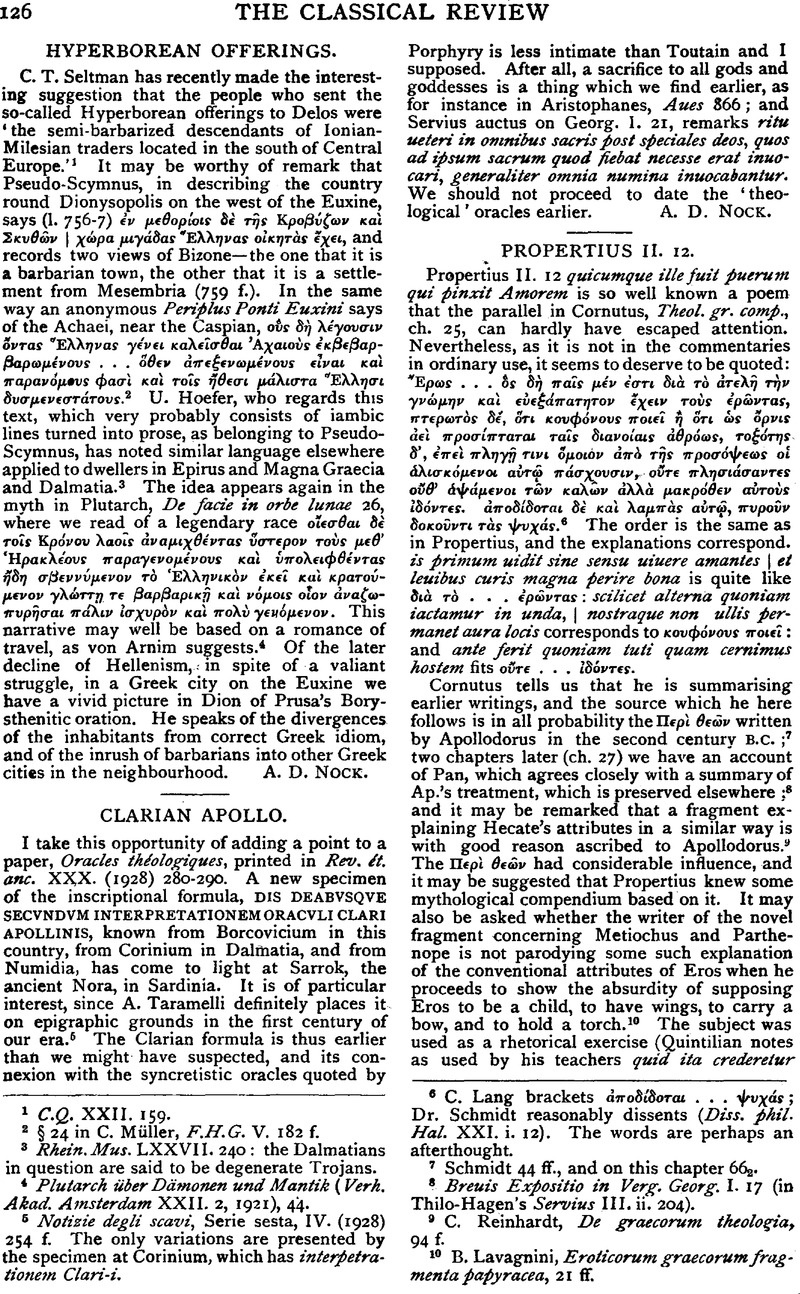No CrossRef data available.
Article contents
Abstract

- Type
- Review Article
- Information
- Copyright
- Copyright © The Classical Association 1929
References
page 126 note 6 6 C. Lang brackets ⋯ποδ⋯δοται … Ψνχ⋯ς; Dr. Schmidt reasonably dissents (Diss. phil. Hal. XXI. i. 12). The words are perhaps an afterthought.
page 126 note 7 Schmidt 44 ff., and on this chapter 662.
page 126 note 8 Breuis Expositio in Verg. Georg. I. 17 (in Thilo-Hagen's Servius III. ii. 204).
page 126 note 9 Reinhardt, C., De graecorum theologia, 94 f.Google Scholar
page 126 note 10 Lavagnini, B., Eroticorum graecorum fragmenta papyracea, 21 ff.Google Scholar
page 127 note 1 Inst. orat. II. 4. 26; cf. Reitzenstein, R., Hellenistische Wundererzahlungen, 167 ff., on the connexion of elegy and rhetoric.Google Scholar
page 127 note 2 Moschus in his Ἔρως δραπ⋯της has this sequence: boy-winged-bow-torch, but no explanation of the first point, and a different explanation of the second. Whether this poem is earlier or later than the Περ⋯ θε⋯ν we cannot say.
page 127 note 3 In his note on Aen. I. 663, like Propertius, he omits the torch. The form of his note, which ends et haec ratio paene in omnibus aliis numinibus pro fiotestatum qualitate formatur, indicates that he has used Apollodorean material rather than Propertius. The phrase puer pingitur suggests in its choice of verb a reminiscence of Propertius, but there is nothing else in the note which does; and Servius seems to quote Propertius once only, on Ecl. 5. 21. Of the use of Apollodorus in ancient notes on Virgil we have remarked an instance earlier. A typical summary occurs in Eustath. in Il. XIV. 315, p. 988, ![]() ; this is clearly commonplace, and what follows comes from Athenaeus XIII., p. 562A. A variant explanation of the wings in Hermeias, in Plut. Phaedr., p. 127. 30, Couvreur (on Eros, Nike, and Hermes they signify τ⋯ν ⋯ναγωγ⋯ν αὐτ⋯ν δ⋯ναμιν).
; this is clearly commonplace, and what follows comes from Athenaeus XIII., p. 562A. A variant explanation of the wings in Hermeias, in Plut. Phaedr., p. 127. 30, Couvreur (on Eros, Nike, and Hermes they signify τ⋯ν ⋯ναγωγ⋯ν αὐτ⋯ν δ⋯ναμιν).
page 127 note 4 Contra Faustum XX. 9 (after a long list of pagan allegorical explanations of myths) et Cupidinem puerum uolitantem ac sagittantem quod irrationabilis et instabilis amor corda uolneret miserorum.
page 127 note 5 Richmond, O. L., C.Q. XII. 69 ff. and p. 27 ff. of his edition.Google Scholar His suggestion that Propertius is imitating Philetas cannot be disproved, and it would be thinkable that Philetas crystallised this commonplace in the shape probably used by Apollodorus. Nevertheless, his arguments for close imitation from the absence of Cynthia's name (C.Q. XII. 70) is not strong (cf. III. 13 and 14, where nostra, 1. 29, is general); and the description of the poet as a mere shadow (1. 20), which suggests to him Philetas, can be paralleled from IV. 5. 63 f. and Ovid, , Tristia III. II. 25.Google Scholar His suggestion that the poet is thinking of a picture of Eros ‘in flight over a sea of troubles’ seems to me a very uncertain inference from the metaphor of lines 7 f., for which cf. Ovid, Rem. Am. 14. Eros is indeed sometimes so represented, as for instance on a vase of Kachrylion; but the reference here is probably to the general type of Eros, as quicumque indicates (I take it that pinxit means in effect ‘painted and fixed the type.’ Eubulus in the well-known fragment ap. Athen. XIII., p. 562c, makes his meaning clear: ![]() ;).
;).
Perhaps I may be allowed to say in gratitude to Professor Richmond how important I think this principle of formal composition is for the study of Propertius.


